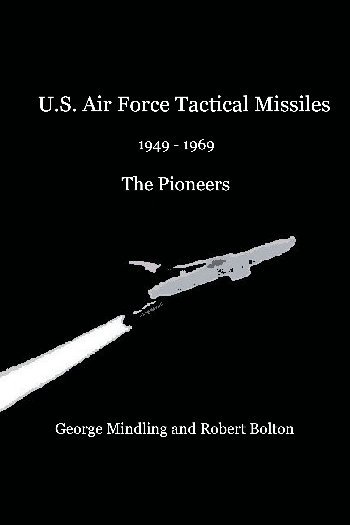U.S. Air Force Tactical Missiles
1949-1969 The Pioneers
Now Available On Line at
Amazon.com and Lulu.com!
| Beyond the Web Page… The only book devoted exclusively to the Matador and Mace Tactical Missiles. The book reveals the story from the initial idea that became the first U.S. pilotless bomber, through the politically troubled development of the ever evolving deployment methods of the Matador and Mace Tactical Missiles. It covers the Units, Groups, Squadrons and Wing that fielded the missiles. From the United States test sites, Europe, Asia and North Africa nothing is omitted. All phases of the application of these two missiles by the U.S. Air Force (and West German Luftwaffe) are included, from the first tentative launches of the XSSM-A-1 Matador in January 1949, to the tense alert duty of the Cuban Missile Crisis, and the final launch of a MQM13A in May of 1977. The maintenance, logistics and launch, the men, equipment and tactics are all there. |
|
“U.S. Air Force Tactical Missiles” is an excellent, comprehensive history of a very little-known aspect of the development and operational deployment of American guided missiles in the early days of the Cold War. The title may lead one to believe that the book is a fairly broad outline of tactical missiles developed during that period. But it really covers just one system–the Glenn L. Martin Company’s TM-61 “Matador” turbojet-powered cruise missile and its follow-on, the upgraded TM-76 “Mace.” “The level of detail in “U.S. Air Force Tactical Missiles” is remarkable. The authors start out with an assessment of the world’s first practical, mass-produced cruise missile–the German V-1 (“Vergeltungswaffe Eins,” or “Vengeance Weapon 1”) “flying bomb” that Hitler used against England and other European targets in World War II. I thought I knew a lot about the V-1, but I learned things I never knew when I read this book. Some of the technical details about its design, construction and method of operation have never, to my knowledge, appeared in print before, at least not in readily accessible form. The authors apply the same level of detail to the story of the design, development, flight testing and overseas deployment of the “Matador” and “Mace,” which trace their lineage directly back to the V-1. Much of “U.S. Air Force Tactical Missiles” is based on reminiscences of former “missileers” with first-hand experience in the care and feeding of “Matadors” and “Maces” in the field. As such, it has the flavor of an “oral history” in which people and their experiences play at least as important a role as the technology.” “Very little has been written about America’s early cruise missiles. As far as I know, “U.S. Air Force Tactical Missiles” is the only available book-length treatment of this relatively obscure subject. An interesting, in-depth and readable volume, “U.S. Air Force Tactical Missiles” deserves a place on the bookshelf of every serious aerospace history buff.” Terry Sunday (sundayt@zianet.com) |
| Dieses Buch ist ein Muss für alle, die im Rahmen ihres Dienstes bei der U.S. Air Force mit den frühen Marschflugkörpern zu tun hatten, aber auch für deutsche Militärarchäologen, die in der Eifel, im Hunsrück oder im Pfälzer Wald schon über rätselhafte Hinterlassenschaften gestolpert sind. Nach mehr als 40 Jahren wird endlich eine Fülle von Fakten, Informationen und Geschichten zu den zwischen 1954 und 1969 in Deutschland stationierten, mit Automwaffen ausgerüsteten amerikanischen Matador und Mace auf den Tisch gelegt. Ausführlich und lebendig erzählen George Mindling und Bob Bolton von den jungen Missilemen, die im März 1954 erstmals in Bitburg ankamen – noch ganz grün im Gesicht, weil auf dem Atlantik schwerer Sturm geherrscht hatte. Von den T-33-Flugzeugen, die aus Übungsgründen so taten, als wären sie Matador-Flugkörper, über die Startstellungen hinweg in Richtung deutsch-deutsche Grenze donnerten und sich von der Gegenseite nur nicht erwischen lassen durften. Oder von der Kuba-Krise, als die US Air Force Europe auf DEFCON 3 ging und an die Mechaniker in Bitburg Munition für ihre Karabiner ausgegeben wurde.Augenzeugen sagen dazu: “Wir hätten die Vögel auf jeden Fall innerhalb von 15 Minuten in der Luft haben müssen!” Es ist lebendige Militärgeschichte, die nun nicht der Vergessenheit anheimfällt, sondern jedermann zugänglich wird – auch für die ortsansässige Bevölkerung, die heute endlich erfährt, was sich damals in ihrer Nachbarschaft zugetragen hat. Den beiden Autoren gebührt der Dank.Klaus Stark (klaus_stark@t-online.de) Berlin, GermanyThis book is not only a must for all those who served in the U.S. Air Force with the early cruise missiles, but also for German military archeologists who have been puzzling over relics stumbled across in the Eifel, the Hunsrück and the Palatinate Forests. After more than 40 years, we finally have a wealth of facts, information and stories, from 1954 to 1969, of the nuclear equipped American Matador and Mace missiles stationed in Germany placed on the table.With detailed and vivid descriptions, George Mindling and Bob Bolton talk about the young Missilemen who arrived for the first time in March, 1954, in Bitburg – still green in the face, having prevailed the Atlantic crossing in major storm. Of the T-33 aircraft which practiced as if they Matador missiles launched in the direction of German-German border, or from the Cuban missile crisis, when the U.S. Air Force Europe went on DEFCON 3 and was issued ammunition to the mechanics in Bitburg for their rifles. Eyewitnesses say: “We would have to have the birds in the air in any event within 15 minutes!” It is vital military history that is prey to oblivion, but is now accessible to everyone – even for the local population, which today finally learns what happened at that time in their neighborhood. The two authors deserve thanks for saving the history. Klaus Stark, |
 Available Now!, Click Here to Order Available Now!, Click Here to Order“U.S. Tactical Missiles 1949-1969 The Pioneers” |


